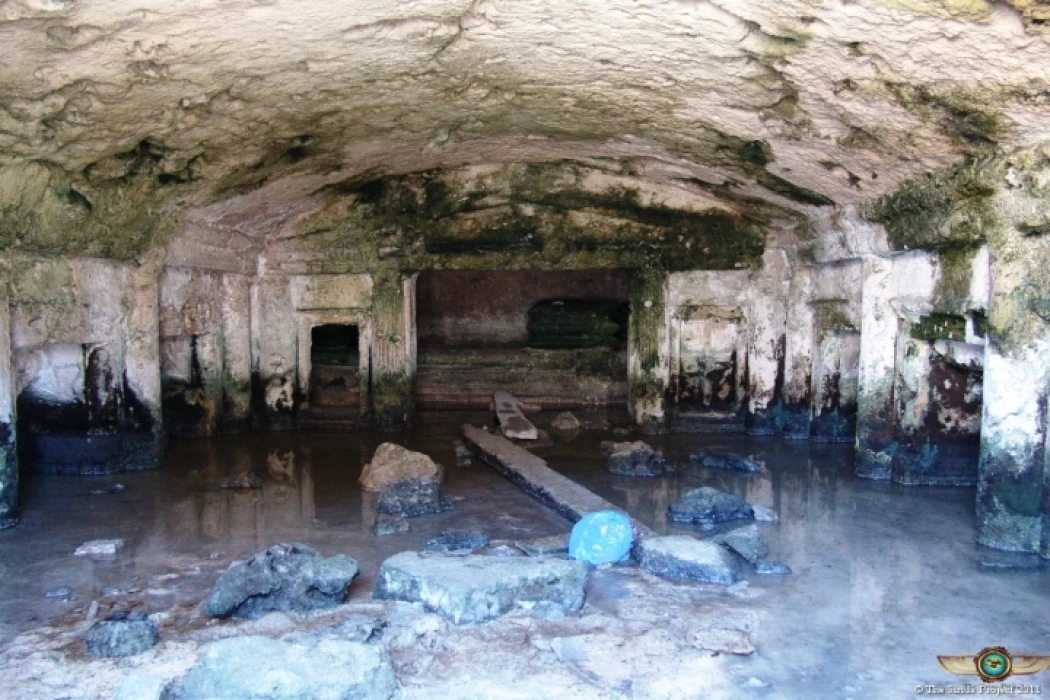
Tomb of Al-Shatby in Alexandria
Tomb of Al-Shatby in Alexandria
As you pass by Shatby Beach and Beram El-Tunisi Theater, and in front of the ancient Saint Mark's School, you will find the Shatby Tombs, which consist of five funerary buildings that combine Greek and Pharaonic civilizations. It is a large tomb divided into many burial chambers that were discovered in 1893, and dates back to between the end of the second century and the beginning of the third century BC.
The Shatby Tombs were carved into the rock and many Ptolemaic artifacts were discovered in them. They are among the oldest Ptolemaic tombs. At first, they were a private tomb for a wealthy family, then used as a public tomb and new parts were added to them. The cemetery includes coffins carved into the rock, equipped with stone pillows in the form of wedding beds, and the ceiling is decorated with wonderful geometric decorations.
Discovery of the Tomb
In 1892, Alexander Max de Zougebe searched the Shatby area up to Ibrahimia until he discovered pots, small statues, lamps and coins. The tomb was also discovered through exploration work carried out by an archaeological team in the Sporting area next to the Ibrahimia Tunnel in order to issue a decision approving the construction of an architectural building containing many artifacts dating back from the Greek era to the Byzantine era.
The period between 1907 and 1928 was marked by continued excavation activities, which were particularly intense during specific years (1912, 1916). The sepulcher contains four rooms, each containing burial apertures. The arrangements of the apertures are done in horizontal lines, one upon another. Also, there may be a maximum of four openings in a single line. They were also embellished easterly with decorative motives and funereal inscriptions in Greek as well.
The initial burial site is referred to as the ‘Soldiers’ Cemetery’ because it is one of the oldest graveyards to be found within the Shatby burial grounds. It consists of a courtyard in the middle of which are two columns of the Doric style, named after the Dorians, the early founders of the Greek civilization, carved into the rock. The ceiling of this cemetery is domed, and it has two openings in which more than ten human skeletons were found. A large number of artifacts were also found in good condition, such as lamps, perfume bottles, and various vessels. The most important of these vessels is the Hadara vase. Such vessels were common in the Greek and Roman periods and were utilized for the purpose of post cremation ashes storage.
In this vase appear engraved scene from the funeral and the name of the dead person is written in Greek letters. This vessel was in very good condition. It was found inside a niche carved into the rock that was closed with stone slabs, some of which were colored and others were engraved in red ink in Greek. It was proven that the tomb was used several times in different eras, as there was more than one layer of mortar on the wall.
The second tomb referred to as the 'sarcophaga abrahamica' is constructed from great blocks of marble and exhibits ornamental designs that are popular in the city of Alexandria. One of these sarcophagi was found at the intersection of Shedia Street and Canopus Street, and two others were found in a street adjacent to Mykerinos Street. They have 8 steps carved into the rock from north to south, leading to the tomb door facing east.
On the front face of each sarcophagus, there is a region with two protrusions decorated in high relief with floral and fruit designs consisting of three heavy tiers, from each of which, a large cluster of grapes is suspended from a curtain. These curtains are tied together with bows and contain four male figures that are placed on square plinths. On the inside, there are two naked boys with exposed bodies leaning on each other, one leaning to the right and the other allowed to lean away from him on the left with their legs separated from each other.
The corners contain two small statues of young men: one turned outwards and the other inwards, each wearing a robe called "Atis", which is a robe with long sleeves, covering the leg to the ankle with trousers, the robe is wrapped around the back and the ends of the robe are tied around the neck below the throat, the robe is open at the belly and chest and a helmet of the Phrygian type is worn on the head. At the center of each garland is a Medusa or Gorgon. To the left of her is the visage of a man bearing fruits and flowers in a wreath. To the right is the face of a lady. And between each sarcophagus are skulls bearing wreaths.
The hollow section of the festoon was filled. Towards the southern part of the area, unembalmed remains of two individuals; a young girl said to be the daughter and an older woman suspected to be the mother were discovered, a gravestone written in Greek as well as thirty-four gold ornaments shaped as vessels, male sex organs fingers and at the base three gold rings. A mosaic from the 3rd century AD was also discovered.
The third and fourth tombs, both of which are at a deeper level than the first tomb, one to the north and the other to the south, contained a large number of archaeological items such as lamps and pottery.














